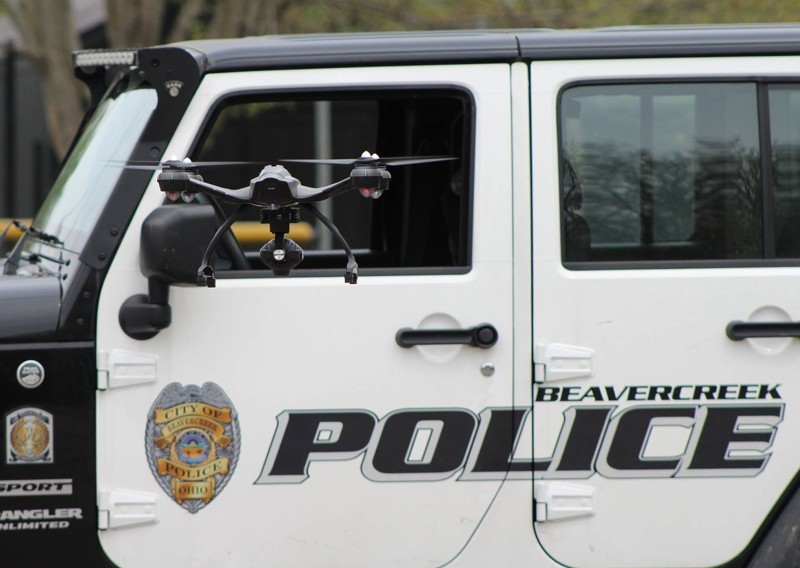The Ohio Attorney General’s Advisory Group on UAS has issued its final report on the use of unmanned aircraft systems (UAS) by law enforcement.
Attorney General Mike DeWine created the group in October 2016. It was made up of law enforcement, UAS stakeholders, and other subject-matter experts. Their report is a response to Ohio's lack of laws about the use of drones by law enforcement.
“It was an emerging issue that there was no model policy in Ohio,” said Dan Tierney, a spokesman for the attorney general. The guidelines were meant to help law enforcement agencies navigate the legal terrain and federal laws, he said.
Ohio Attorney General Mike DeWine’s Unmanned Aircraft Systems advisory group consulted with Ohio law enforcement agencies to develop a model law enforcement policy for the use of unmanned aircraft systems (UAS). They collaborated to create recommendations on best practices and protocols that agencies can consider when designing UAS policies. They also looked at advanced training courses that focus on the practical uses of UAS.
While the advisory group was initially formed with the goal of developing a UAS model policy template for law enforcement, the members of the advisory group also created 14 recommendations. These recommendations, in addition to the model policy template, cover these topic areas: certifications and authorizations; procedures and uses; privacy; digital evidence and data management; training; and technology.
The advisory group recommends:
- Each law enforcement agency with a UAS program should develop and implement a written policy, using the model policy included in this report as a guide.
- Law enforcement agencies should require that any staff member operating a UAS have a current remote pilot certificate per 14 Code of Federal Regulations (CFR) Part 107 issued by the Federal Aviation Administration (FAA).
- Law enforcement agencies should review their needs and the applicability of a Certificate of Waiver or Authorization (COA) before applying to the FAA for one.
- All UAS vehicles should be tested and inspected prior to each use.
- Each law enforcement agency should determine its own set of approved uses of UAS.
- Law enforcement agencies should obtain a search warrant before any use where people would have a reasonable expectation of privacy.
- UAS operators should take measures to avoid incidentally recording images of people who are not relevant to an approved use of UAS.
- UAS should never be used to conduct unauthorized surveillance.
- Law enforcement agencies should work with legal counsel to develop guidelines governing the agency’s use of UAS.
- Law enforcement agencies should develop and implement effective management policies for data collected through UAS use.
- When law enforcement agencies employ or contract with another party to operate UAS for law enforcement purposes, law enforcement agencies should ensure that they retain ownership and control over all data collected.
- Law enforcement agencies’ pilots and support crew members should engage in applicable skills training no less than once a month in order to retain the knowledge and skills of UAS use.
- Law enforcement agencies’ pilots and support crew should attend an annual training covering updated industry standards, field exercises, review of regulations, and maintenance requirements.
- Law enforcement agencies should work with their respective political subdivisions to clearly identify the needs and available resources for a UAS program.
The UAS Model Policy Template for Ohio Law Enforcement Agencies is written to be customized to suit agencies of any size or with any level of resources. While drafting the document, the group reviewed and discussed many policies from law enforcement agencies throughout Ohio and in other states.
Through its research, the advisory group found several sections in the IACP model policy that law enforcement agencies should consider:
- The document should offer a clearly stated policy regarding when, where, and how UAS will be used.
- It should include procedures that the agency will follow to ensure safe, legally compliant and effective UAS use.
- It should cover digital multimedia evidence storage- and retention-procedures, including references to relevant statutes and rules.
- It should include audit protocols for both flight and digital multimedia evidence audits.
- It should provide details on training requirements for all personnel assigned to operate UAS.
Drones can be used by law enforcement for a number of investigative purposes, such as crime scene and traffic accident investigations, missing persons cases, SWAT operations, and active shooter incidents. However, the use of UAS for law enforcement purposes is relatively new and has prompted privacy and safety concerns among citizens.
One civil liberties group contended this list of recommendations to police on the use of drones does not go far enough to protect privacy but this does seem like a step in the right direction. Law enforcement agencies and the public can benefit from drone use by law enforcements.
Find out more about current State drone laws and regulations through our Learning Center, there you will find drone laws for each state.


